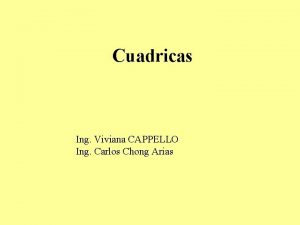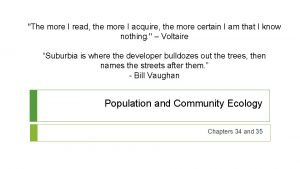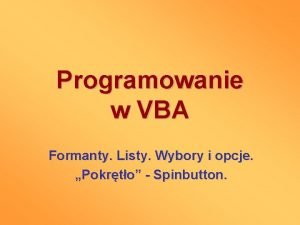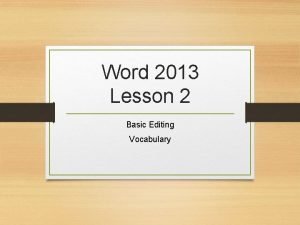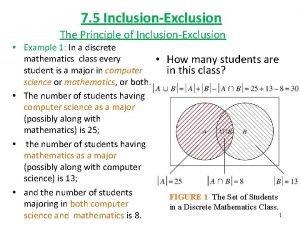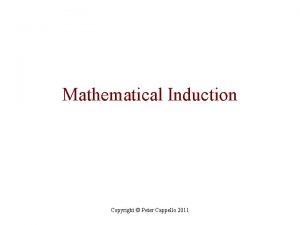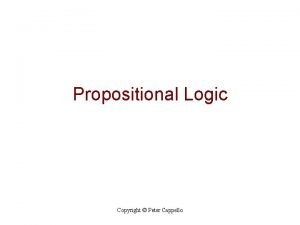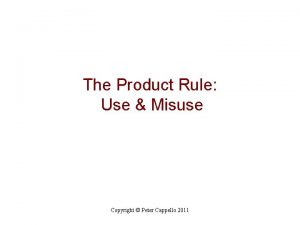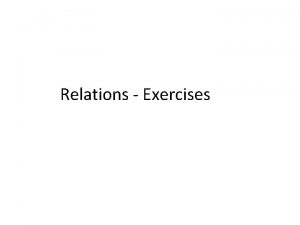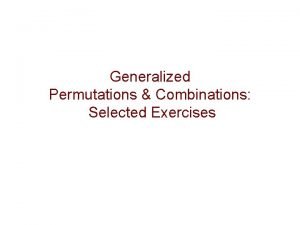InclusionExclusion Selected Exercises Copyright Peter Cappello 2011 Exercise













- Slides: 13

Inclusion-Exclusion Selected Exercises Copyright © Peter Cappello 2011

Exercise 10 Find the number of positive integers not exceeding 100 that are not divisible by 5 or 7. (Numbers 100 that are not divisible by 5 and are not divisible by 7. ) See Venn diagram. Copyright © Peter Cappello 2011 2

Exercise 10 Solution Let the “bad” numbers be those that are divisible by 5 or 7. Subtract the number of “bad” numbers from the size of the universe: 100. – Let A 5 denote the numbers 100 that are divisible by 5. – Let A 7 denote the numbers 100 that are divisible by 7. – | A 5 A 7 | = | A 5 | + | A 7 | - | A 5 A 7 | = └ 100/5 ┘ + └ 100/7 ┘ - └ 100/(5. 7) ┘ = 20 + 14 – 2 = 32. The answer is 100 – 32 = 68. Copyright © Peter Cappello 2011 3

Exercise 14 How many permutations of the 26 letters of the English alphabet do not contain any of the strings fish, rat, or bird? See Venn diagram. Copyright © Peter Cappello 2011 4

Exercise 14 Solution 1. 2. Start with the universe: 26! Subtract the permutations that contain: – fish. To count the number of permutations with a fixed substring: Treat the fixed substring as 1 letter. There are (26 – 4 + 1)! such permutations. – – 3. Add the permutations that contain: – – – 4. rat: (26 – 3 + 1)! bird: : (26 – 4 + 1)! fish & rat: (26 – 4 – 3 + 2)! fish & bird: 0 rat & bird: 0 Subtract the permutations that contain all 3 strings There are 0 such permutations. Answer: 26! – 23! – 24! – 23! + 21! Copyright © Peter Cappello 2011 5

The Principle of Inclusion-Exclusion | A 1 A 2 | = | A 1 | + | A 2 | - | A 1 A 2 | | A 1 A 2 A 3 | = | A 1 | + | A 2 | + | A 3 | - | A 1 A 2 | - | A 1 A 3 | - | A 2 A 3 | + | A 1 A 2 A 3 | Copyright © Peter Cappello 2011 6

The Principle of Inclusion-Exclusion | A 1 A 2 . . . An | = Σ | Ai | - Σ | Ai Aj | + Σ | Ai Aj Ak | - . . . + (-1) n-1 Σ | A 1 A 2 . . . An | Copyright © Peter Cappello 2011 7

Proof 1. An element in exactly 0 of the sets is counted by the RHS 0 times. 2. An element in exactly 1 of the sets is counted by the RHS 1 time. 3. An element in exactly 2 of the sets is counted by the RHS 2 – 1 = 1 time. 4. An element in exactly 3 of the sets is counted by the RHS 3 – 3 + 1 = 1 time. m. An element in exactly m of the sets is counted by the RHS C( m, 1 ) – C( m, 2) + C( m, 3 ) -. . . + (-1)m-1 C( m, m ) times. Copyright © Peter Cappello 2011 8

Proof ( x + y )n = C( n, 0 )xny 0 + C( n, 1 )xn-1 y 1 + … C( n, n )x 0 yn Evaluate the Binomial Theorem, at x = 1, y = -1, we obtain (1 – 1)n = C( n, 0 ) – C( n, 1 ) + C( n, 2 ) - … + (-1)n-1 C( n, n ) C( n, 1 ) – C( n, 2 ) + … + (-1)n. C( n, n ) = C( n, 0 ) = 1. Copyright © Peter Cappello 2011 9

Exercise 18 How many terms are there in the formula for the # of elements in the union of 10 sets given by the inclusion -exclusion principle? Copyright © Peter Cappello 2011 10

Exercise 18 Solution It is the sum of the: Terms with 1 set: C( 10, 1 ) Terms with 2 -way intersections: C( 10, 2 ) Terms with 3 -way intersections: C( 10, 3 ) Terms with 4 -way intersections: C( 10, 4 ) Terms with 5 -way intersections: C( 10, 5 ) Terms with 6 -way intersections: C( 10, 6 ) Terms with 7 -way intersections: C( 10, 7 ) Terms with 8 -way intersections: C( 10, 8 ) Terms with 9 -way intersections: C( 10, 9 ) Terms with 10 -way intersections: C( 10, 10 ) The total is 210 – 1 = 1, 023. Copyright © Peter Cappello 2011 11

Exercise 20 How many elements are in the union of 5 sets if: – The sets contain 10, 000 elements – Each pair of sets has 1, 000 common elements – Each triple of sets has 100 common elements – Each quadruple of sets has 10 common elements – All 5 sets have 1 common element. Copyright © Peter Cappello 2011 12

Exercise 20 Solution To count the size of the union of the 5 sets: – Add the sizes of each set: C(5, 1)10, 000 – Subtract the sizes of the 2 -way intersections: C(5, 2)1, 000 – Add the sizes of the 3 -way intersections: C(5, 3)100 – Subtract the sizes of the 4 -way intersections: C(5, 4)10 – Add the size of the 5 -way intersection: C(5, 5)1 C(5, 1)10, 000 - C(5, 2)1, 000 + C(5, 3)100 - C(5, 4)10 + C(5, 5)1 Copyright © Peter Cappello 2011 13
 Cappello bianco de bono pensiero verticale
Cappello bianco de bono pensiero verticale Maja cappello
Maja cappello Viviana cappello
Viviana cappello Instruments in quantitative research
Instruments in quantitative research Survivorship curve for k selected species
Survivorship curve for k selected species What is selected response
What is selected response Qualitative quantitative
Qualitative quantitative Vba listbox selected item value
Vba listbox selected item value K selected species survivorship curve
K selected species survivorship curve Example of r selected species
Example of r selected species Allergy therapy makes bees go away
Allergy therapy makes bees go away Removes selected text and places it on the clipboard
Removes selected text and places it on the clipboard Dubai population pyramid
Dubai population pyramid Not only the students but also the instructor
Not only the students but also the instructor


